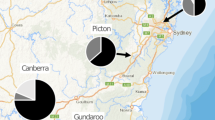Summary
Analysis of allozyme markers was carried out on 16 colonies of the termiteIncisitermes schwarzi in which one or both primary (founding) reproductives had been replaced by secondary reproductives. About one-quarter of field-collected colonies have replacement reproductives, and the genetic data suggest that in most of these a single replacement event had occurred. Genetic evidence for a second replacement event was found in one colony. Genetic analysis of the offspring allowed the following conclusions: (1) Soldiers are a relatively long-lived caste, so that even in colonies in which all other members have been replaced by offspring of the secondary reproductives, the soldiers remain the offspring of the primary reproductives; and (2) when primary reproductives are replaced by secondary reproductives, the nosoldier offspring of the former are completely replaced by those of the latter over a period of about two or three years, probably as a result of the normal maturation of colony members (workers, nymphs, and alates). The results provide no evidence for the existence of a true sterile worker caste in this species.
Similar content being viewed by others
References
Clément, J.-L., 1981. Enzymatic polymorphism in the European populations of variousReticulitermes species (Isoptera). In:Biosystematics of Social Insects (P. E. Howse, J.-L. Clément, Eds.), Academic Press, London and New York, pp. 49–62.
Clément, J.-L., 1984. Diagnostic alleles and systematics in termite species of the genusReticulitermes in Europe.Experientia 40:283–285.
Kalshoven, L. G. E., 1930. De biologie van de djatitermiet (Kalotermes tectonae Damm.) in verband met zjin bestrijding.Mededeelingen van het Instituut voor Plantenziekten, No. 76, pp. 1–154.
Grasse, P.-P., 1982.Termitologia: Anatomie, Physiologie, Biologie, Systématique des Termites, Masson, Paris, t. I, ch. 22.
Lüscher, M., 1952. Untersuchungen über das individuelle Wachstum bei der TermiteKalotermes flavicollis Fabr. (ein Beitrag zum Kastenbildungsproblem).Biol. Zbl. 71:529–543.
Luykx, P., 1985. Genetic relations among castes in lower termites. In:Caste Differentiation in Social Insects (J. A. L. Watson, B. M. Okot-Kotber, C. Noirot, Eds.), Oxford, New York, etc.: Pergamon Press, ch. 6, pp. 17–25.
Luykx, P., 1986. Termite colony dynamics as revealed by the sex- and caste-ratios of whole colonies ofIncisitermes schwarzi Banks (Isoptera: Kalotermitidae).Ins. Soc. 33:221–248.
Luykx, P., 1993. Allozyme markers and formal Mendelian genetics of the termiteIncisitermes schwarzi Banks.Sociobiology 21:185–192.
Luykx, P., J. Michel and J. Luykx, 1986. The spatial distribution of the sexes in colonies of the termiteIncisitermes schwarzi Banks (Isoptera: Kalotermitidae).Ins. Soc. 33:406–421.
Miller, E. M., 1969. Caste differentiation in the lower termites. In:Biology of Termites (K. Krishna, F. M. Weesner, Eds.), New York and London, Academic Press,vol. I, pp. 283–310.
Myles, T. G. and W. L. Nutting, 1988. Termite eusocial evolution: a re-examination of Bartz's hypothesis and assumptions.Quart. Rev. Biol. 63:1–23.
Nagin, R. D., 1972. Caste determination inNeotermes jouteli.Ins. Soc. 19:39–61.
Nickle, D. A. and M. S. Collins, 1989. Key to the Kalotermitidae of eastern United States with a newNeotermes from Florida (Isoptera).Proc. Entomol. Soc. Wash. 91:269–285.
Noirot, C., 1969. Formation of castes in higher termites. In:Biology of Termites (K. Krishna, F. M. Weesner, Eds.), New York and London, Academic Press,vol. I, pp. 311–350.
Noirot, C., 1985a. The caste system in higher termites. In:Caste Differentiation in Social Insects (J. A. L. Watson, B. M. Okot-Kotber, C. Noirot, Eds.), Oxford, New York, etc.: Pergamon Press, ch. 6, pp. 75–86.
Noirot, C., 1985b. Pathways of caste development in the lower termites. In:Caste Differentiation in Social Insects (J. A. L. Watson, B. M. Okot-Kotber, C. Noirot, Eds.), Oxford, New York, etc.: Pergamon Press, ch. 4, pp. 41–57.
Noirot, C. and J. M. Pasteels, 1987. Ontogenetic development and evolution of the worker caste in termites.Experientia 43:851–860.
Noirot, C. and J. M. Pasteels, 1988. The worker caste is polyphyletic in termites.Sociobiology 14:15–20.
Richards, O. W. and R. G. Davies, 1977.Imms' General Textbook of Entomology, 10th ed., London, Chapman and Hall.
Richardson, B. J., P. R. Baverstock and M. Adams, 1986.Allozyme Electrophoresis. A Handbook for Animal Systematics and Population Studies. Sydney, Orlando, etc.: Academic Press.
Roisin, Y., 1990. Reversibility of regressive molts in the termiteNeotermes papua.Naturwiss. 77:246–247.
Ruppli, E., 1969. Die Elimination überzähliger Ersatzgeschlechtstiere bei der TermiteKalotermes flavicollis (Fabr.).Ins. Soc. 16:235–248.
Santos, O. and P. Luykx, 1985. Holozygosity for sex-linked genes in males of the termiteIncisitermes schwarzi.Biochem. Genet. 23:729–740.
Sewell, J. J. and J. A. L. Watson, 1981. Developmental pathways in Australian species ofKalotermes Hagen (Isoptera),Sociobiology 6:243–323.
Springhetti, A., 1985. The function of the royal pair in the society ofKalotermes flavicollis (Fabr.) (Isoptera: Kalotermitidae). In:Caste Differentiation in Social Insects (J. A. L. Watson, B. M. Okot-Kotber, C. Noirot, Eds.), Oxford, New York, etc.: Pergamon Press, ch. 11, pp. 165–175.
Watson, J. A. L. and J. J. Sewell, 1981. The origin and evolution of caste systems in termites.Sociobiology 6:101–118.
Watson, J. A. L. and J. J. Sewell, 1985. Caste development inMastotermes and Kalotermes: which is primitive? In:Caste Differentiation in Social Insects (J. A. L. Watson, B. M. Okot-Kotber, C. Noirot, Eds.), Oxford, New York, etc.: Pergamon Press, ch. 3, pp. 27–40.
Author information
Authors and Affiliations
Rights and permissions
About this article
Cite this article
Luykx, P. Turnover in termite colonies: a genetic study of colonies ofIncisitermers schwarzi headed by replacement reproductives. Ins. Soc 40, 191–205 (1993). https://doi.org/10.1007/BF01240707
Received:
Revised:
Accepted:
Issue Date:
DOI: https://doi.org/10.1007/BF01240707




